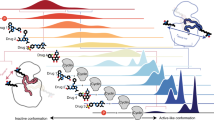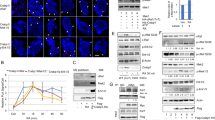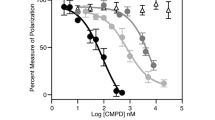Abstract
The phosphorylation state and corresponding activity of the retinoblastoma tumor suppressor protein (Rb) are modulated by a balance of kinase and phosphatase activities. Here we characterize the association of Rb with the catalytic subunit of protein phosphatase 1 (PP1c). A crystal structure identifies an enzyme docking site in the Rb C-terminal domain that is required for efficient PP1c activity toward Rb. The phosphatase docking site overlaps with the known docking site for cyclin-dependent kinase (Cdk), and PP1 competition with Cdk-cyclins for Rb binding is sufficient to retain Rb activity and block cell-cycle advancement. These results provide the first detailed molecular insights into Rb activation and establish a novel mechanism for Rb regulation in which kinase and phosphatase compete for substrate docking.
This is a preview of subscription content, access via your institution
Access options
Subscribe to this journal
Receive 12 print issues and online access
$189.00 per year
only $15.75 per issue
Buy this article
- Purchase on Springer Link
- Instant access to full article PDF
Prices may be subject to local taxes which are calculated during checkout






Similar content being viewed by others
References
Dyson, N. The regulation of E2F by pRB-family proteins. Genes Dev. 12, 2245–2262 (1998).
Weinberg, R.A. The retinoblastoma protein and cell cycle control. Cell 81, 323–330 (1995).
Brehm, A. et al. Retinoblastoma protein recruits histone deacetylase to repress transcription. Nature 391, 597–601 (1998).
Kennedy, B.K. et al. Histone deacetylase-dependent transcriptional repression by pRB in yeast occurs independently of interaction through the LXCXE binding cleft. Proc. Natl. Acad. Sci. USA 98, 8720–8725 (2001).
Nielsen, S.J. et al. Rb targets histone H3 methylation and HP1 to promoters. Nature 412, 561–565 (2001).
Zhang, H.S. et al. Exit from G1 and S phase of the cell cycle is regulated by repressor complexes containing HDAC-Rb-hSWI/SNF and Rb-hSWI/SNF. Cell 101, 79–89 (2000).
Adams, P.D. Regulation of the retinoblastoma tumor suppressor protein by cyclin/cdks. Biochim. Biophys. Acta 1471, M123–M133 (2001).
Harbour, J.W., Luo, R.X., Dei Santi, A., Postigo, A.A. & Dean, D.C. Cdk phosphorylation triggers sequential intramolecular interactions that progressively block Rb functions as cells move through G1. Cell 98, 859–869 (1999).
Wu, J.Q. et al. PP1-mediated dephosphorylation of phosphoproteins at mitotic exit is controlled by inhibitor-1 and PP1 phosphorylation. Nat. Cell Biol. 11, 644–651 (2009).
Ludlow, J.W., Glendening, C.L., Livingston, D.M. & DeCarprio, J.A. Specific enzymatic dephosphorylation of the retinoblastoma protein. Mol. Cell. Biol. 13, 367–372 (1993).
Ludlow, J.W., Shon, J., Pipas, J.M., Livingston, D.M. & DeCaprio, J.A. The retinoblastoma susceptibility gene product undergoes cell cycle-dependent dephosphorylation and binding to and release from SV40 large T. Cell 60, 387–396 (1990).
Krucher, N.A. et al. Dephosphorylation of Rb (Thr-821) in response to cell stress. Exp. Cell Res. 312, 2757–2763 (2006).
Dou, Q.P., An, B. & Will, P.L. Induction of a retinoblastoma phosphatase activity by anticancer drugs accompanies p53-independent G1 arrest and apoptosis. Proc. Natl. Acad. Sci. USA 92, 9019–9023 (1995).
Classon, M. & Harlow, E. The retinoblastoma tumour suppressor in development and cancer. Nat. Rev. Cancer 2, 910–917 (2002).
Sherr, C.J. Cancer cell cycles. Science 274, 1672–1677 (1996).
Morgan, D.O. Principles of CDK regulation. Nature 374, 131–134 (1995).
Broceno, C., Wilkie, S. & Mittnacht, S. RB activation defect in tumor cell lines. Proc. Natl. Acad. Sci. USA 99, 14200–14205 (2002).
Durfee, T. et al. The retinoblastoma protein associates with the protein phosphatase type 1 catalytic subunit. Genes Dev. 7, 555–569 (1993).
Cohen, P.T. Protein phosphatase 1–targeted in many directions. J. Cell Sci. 115, 241–256 (2002).
Terrak, M., Kerff, F., Langsetmo, K., Tao, T. & Dominguez, R. Structural basis of protein phosphatase 1 regulation. Nature 429, 780–784 (2004).
Egloff, M.P. et al. Structural basis for the recognition of regulatory subunits by the catalytic subunit of protein phosphatase 1. EMBO J. 16, 1876–1887 (1997).
Kiss, A. et al. Myosin phosphatase interacts with and dephosphorylates the retinoblastoma protein in THP-1 leukemic cells: its inhibition is involved in the attenuation of daunorubicin-induced cell death by calyculin-A. Cell. Signal. 20, 2059–2070 (2008).
Nelson, D.A., Krucher, N.A. & Ludlow, J.W. High molecular weight protein phosphatase type 1 dephosphorylates the retinoblastoma protein. J. Biol. Chem. 272, 4528–4535 (1997).
Tamrakar, S. & Ludlow, J.W. The carboxyl-terminal region of the retinoblastoma protein binds non-competitively to protein phosphatase type 1α and inhibits catalytic activity. J. Biol. Chem. 275, 27784–27789 (2000).
Vietri, M., Bianchi, M., Ludlow, J.W., Mittnacht, S. & Villa-Moruzzi, E. Direct interaction between the catalytic subunit of protein phosphatase 1 and pRb. Cancer Cell Int. 6, 3 (2006).
Rubin, S.M., Gall, A.L., Zheng, N. & Pavletich, N.P. Structure of the Rb C-terminal domain bound to E2F1–DP1: a mechanism for phosphorylation-induced E2F release. Cell 123, 1093–1106 (2005).
Adams, P.D. et al. Retinoblastoma protein contains a C-terminal motif that targets it for phosphorylation by cyclin-cdk complexes. Mol. Cell. Biol. 19, 1068–1080 (1999).
Ji, P. et al. An Rb-Skp2-p27 pathway mediates acute cell cycle inhibition by Rb and is retained in a partial-penetrance Rb mutant. Mol. Cell 16, 47–58 (2004).
Welch, P.J. & Wang, J.Y. A C-terminal protein-binding domain in the retinoblastoma protein regulates nuclear c-Abl tyrosine kinase in the cell cycle. Cell 75, 779–790 (1993).
Xiao, Z.X. et al. Interaction between the retinoblastoma protein and the oncoprotein MDM2. Nature 375, 694–698 (1995).
Lowe, E.D. et al. Specificity determinants of recruitment peptides bound to phospho-CDK2/cyclin A. Biochemistry 41, 15625–15634 (2002).
Schulman, B.A., Lindstrom, D.L. & Harlow, E. Substrate recruitment to cyclin-dependent kinase 2 by a multipurpose docking site on cyclin A. Proc. Natl. Acad. Sci. USA 95, 10453–10458 (1998).
Egloff, M.P., Cohen, P.T., Reinemer, P. & Barford, D. Crystal structure of the catalytic subunit of human protein phosphatase 1 and its complex with tungstate. J. Mol. Biol. 254, 942–959 (1995).
Goldberg, J. et al. Three-dimensional structure of the catalytic subunit of protein serine/threonine phosphatase-1. Nature 376, 745–753 (1995).
Tamrakar, S., Mittnacht, S. & Ludlow, J.W. Binding of select forms of pRB to protein phosphatase type 1 independent of catalytic activity. Oncogene 18, 7803–7809 (1999).
Meiselbach, H., Sticht, H. & Enz, R. Structural analysis of the protein phosphatase 1 docking motif: molecular description of binding specificities identifies interacting proteins. Chem. Biol. 13, 49–59 (2006).
Huang, H.J. et al. Suppression of the neoplastic phenotype by replacement of the RB gene in human cancer cells. Science 242, 1563–1566 (1988).
Hinds, P.W. et al. Regulation of retinoblastoma protein functions by ectopic expression of human cyclins. Cell 70, 993–1006 (1992).
Zhu, L. et al. Inhibition of cell proliferation by p107, a relative of the retinoblastoma protein. Genes Dev. 7, 1111–1125 (1993).
Margolis, S.S. et al. PP1 control of M phase entry exerted through 14–3-3-regulated Cdc25 dephosphorylation. EMBO J. 22, 5734–5745 (2003).
Ferrell, J.E. Jr. Tripping the switch fantastic: how a protein kinase cascade can convert graded inputs into switch-like outputs. Trends Biochem. Sci. 21, 460–466 (1996).
Goldbeter, A. & Koshland, D.E. Jr. An amplified sensitivity arising from covalent modification in biological systems. Proc. Natl. Acad. Sci. USA 78, 6840–6844 (1981).
Salazar, C. & Hofer, T. Competition effects shape the response sensitivity and kinetics of phosphorylation cycles in cell signaling. Ann. NY Acad. Sci. 1091, 517–530 (2006).
Thomson, M. & Gunawardena, J. Unlimited multistability in multisite phosphorylation systems. Nature 460, 274–277 (2009).
Tanoue, T., Adachi, M., Moriguchi, T. & Nishida, E. A conserved docking motif in MAP kinases common to substrates, activators and regulators. Nat. Cell Biol. 2, 110–116 (2000).
Zhang, Z., Zhao, S., Zirattu, S.D., Bai, G. & Lee, E.Y. Expression of recombinant inhibitor-2 in E. coli and its utilization for the affinity chromatography of protein phosphatase-1. Arch. Biochem. Biophys. 308, 37–41 (1994).
Russo, A.A. Purification and reconstitution of cyclin-dependent kinase 2 in four states of activity. Methods Enzymol. 283, 3–12 (1997).
Burke, J.R., Deshong, A.J., Pelton, J.G. & Rubin, S.M. Phosphorylation-induced conformational changes in the retinoblastoma protein inhibit E2F transactivation domain binding. J. Biol. Chem. 285, 16286–16293 (2010).
van den Heuvel, S. & Harlow, E. Distinct roles for cyclin-dependent kinases in cell cycle control. Science 262, 2050–2054 (1993).
Seifried, L.A. et al. pRB-E2F1 complexes are resistant to adenovirus E1A-mediated disruption. J. Virol. 82, 4511–4520 (2008).
Acknowledgements
The authors acknowledge the staff at Beamline 5.0.1 of the Advanced Light Source (Lawrence Berkeley National Laboratories) and are grateful to N. Dyson (Massachusetts General Hospital) for CMV-CycA and T. Pawson (MSHRI, Toronto) for the CMV-myc-PP1c plasmid. The Rb 4.1 hybridoma developed by J. Sage was obtained from the Developmental Studies Hybridoma Bank developed under the auspices of the US National Institute of Child Health and Human Development and maintained by The University of Iowa, Department of Biology. This work is supported by grants from the Canadian Institutes of Health Research (MOP89765 to F.A.D.) and the US National Institutes of Health (R01CA132685 to S.M.R.). A.H. is supported by a US National Institutes of Health training grant (T32GM008646). M.C. acknowledges the Canadian Institutes of Health Research for an M.D./Ph.D. studentship award and the CaRTT training program. A.H. and S.M.R. thank the Santa Cruz Cancer Benefit Group for their support. F.A.D. thanks the Canadian Cancer Society for a Research Scientist Award. S.M.R. is a Pew Scholar in the Biomedical Sciences.
Author information
Authors and Affiliations
Contributions
A.H., M.C., F.A.D. and S.M.R. all designed aspects of the study; A.H., M.C., R.C.S., M.R.S. and S.M.R. performed experiments; all authors analyzed data; F.A.D. and S.M.R. wrote the manuscript.
Corresponding author
Ethics declarations
Competing interests
The authors declare no competing financial interests.
Supplementary information
Supplementary Text and Figures
Supplementary Figures 1–8 and Supplementary Methods (PDF 6834 kb)
Rights and permissions
About this article
Cite this article
Hirschi, A., Cecchini, M., Steinhardt, R. et al. An overlapping kinase and phosphatase docking site regulates activity of the retinoblastoma protein. Nat Struct Mol Biol 17, 1051–1057 (2010). https://doi.org/10.1038/nsmb.1868
Received:
Accepted:
Published:
Issue Date:
DOI: https://doi.org/10.1038/nsmb.1868
This article is cited by
-
Upregulation of WDR6 drives hepatic de novo lipogenesis in insulin resistance in mice
Nature Metabolism (2023)
-
Post-translational modifications on the retinoblastoma protein
Journal of Biomedical Science (2022)
-
Structure of the SHOC2–MRAS–PP1C complex provides insights into RAF activation and Noonan syndrome
Nature Structural & Molecular Biology (2022)
-
Non-canonical functions of the RB protein in cancer
Nature Reviews Cancer (2018)
-
Motif co-regulation and co-operativity are common mechanisms in transcriptional, post-transcriptional and post-translational regulation
Cell Communication and Signaling (2015)



